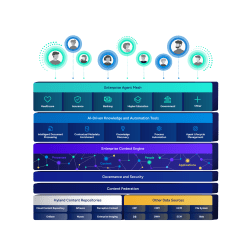Guide to modernizing insurance
Considering a technology upgrade? This legacy assessment provides answers.

Harness the power of a unified content, process and application intelligence platform to unlock the value of enterprise content.
Learn more
Automate your document-centric processes with AI-powered document capture, separation, classification, extraction and enrichment.
Learn about Hyland IDPIt's your unique digital evolution … but you don't have to face it alone. We understand the landscape of your industry and the unique needs of the people you serve.
 Overview of industries
Overview of industries
Countless teams and departments have transformed the way they work in accounting, HR, legal and more with Hyland solutions.
 Overview of departments
Overview of departments
We are committed to helping you maximize your technology investment so you can best serve your customers.
 Overview of services
Overview of services

Discover why Hyland is trusted by thousands of organizations worldwide.
Hear from our customers
Our exclusive partner programs combine our strengths with yours to create better experiences through content services.
Overview of partners
Join The Shift newsletter for the latest strategies and expert tips from industry leaders. Discover actionable steps to stay innovative.
Register now
Hyland connects your content and systems so you can forge stronger connections with the people who matter most.
Learn about HylandWith our modern, open and cloud-native platforms, you can build strong connections and keep evolving.
 Dig deeper
Dig deeper
Reading time minutes
Considering a technology upgrade? This legacy assessment provides answers.

As they try to stand out in a hypercompetitive market, insurance carriers focus on customer satisfaction, costs savings and efficiency. Too often, though, they rely on legacy systems that deliver inconsistent customer experiences and make it difficult to create personalized communications.
According to research by PwC, insurers spend about 70% of their IT budgets on maintaining legacy systems. Other estimates have the legacy maintenance spend as high as 75%.
Antiquated systems are inefficient and costly to maintain, and they simply aren’t able to support the capabilities required for success in the foreseeable future.
If your IT systems are a decade old and increasingly causing setbacks, it’s time to consider modernizing your technology solutions — for the sake of your customers and your staff.
Modernization is recognized as a strategic solution to navigating the challenges of outdated legacy systems. One that promises huge returns — resource optimization, higher scalability, personalization, quicker response times and more efficient service to customers.
But first, it’s time for an assessment. Before making the decision to modernize IT systems, insurers need to evaluate their current systems to truly understand what technology solutions will resolve legacy issues and where they can make the most impact.
— Kyle Swearingen, Vice President of Development, Funeral Directors Life
There are a number of factors that should be considered when undertaking a system assessment — the age of the hardware/software, its interoperability with claims and policy systems, whether it supports changes in the business processes model, the frequency of hardware failures and crashes, and, generally, its overall performance.
Here is a checklist of questions to ask yourself to gain a complete and fundamental understanding of your existing systems:
Your answers should provide a clear perspective of whether modernizing your legacy system is a necessity for your agency.
Technology solutions can revolutionize efficiency, accessibility and effectiveness for all users. That’s why insurers must leverage every advantage that these solutions have to offer.
Insurers can utilize artificial intelligence (AI) to ingest incoming information, no matter its source, and make it accessible and usable.
Leverage tools like rapid application development (RAD) to tailor solutions to your needs with configurable point-and-click capabilities. You can also develop solutions that scale and shift with evolving business and customer needs on one platform — and extend it across departments for agility and effectiveness.
Gain complete visibility into your processes from start to finish with workflow automation. Intelligent automation improves processes by connecting information across core systems and workflows, freeing up staff to focus on more strategic work.
Migrating to a modern cloud-based platform with a shared services model can help insurers centralize siloed IT solutions on a single platform that provides secure content storage and collaboration while ensuring ownership and control. Plus, being hosted in the cloud means information is accessible from anywhere with real-time data, improving efficiency and transparency.
Number of solutions aYo considered before selecting Hyland to automate claims processing
Hours in manual processes that Funeral Directors Life saved over two years with end-to-end claims automation
Amount Funeral Directors Life’s claims volume increased in the two-year period
Although transforming legacy IT systems into a modern and agile system can be challenging, it’s imperative for insurers to meet the demands of today’s savvy digital customers.
Intelligent content solutions are capable of delivering a modern, robust and holistic solution. With its diverse range of capabilities, a content services solution will be instrumental in your modernization initiatives while offering scalability and sustainability for the future.

Explore the factors that make an organization in the insurance industry resilient and agile.

Global insurer saves $21 million over five years with assistance from Hyland.

Advanced technology has potential to transform insurance operations across various functions.